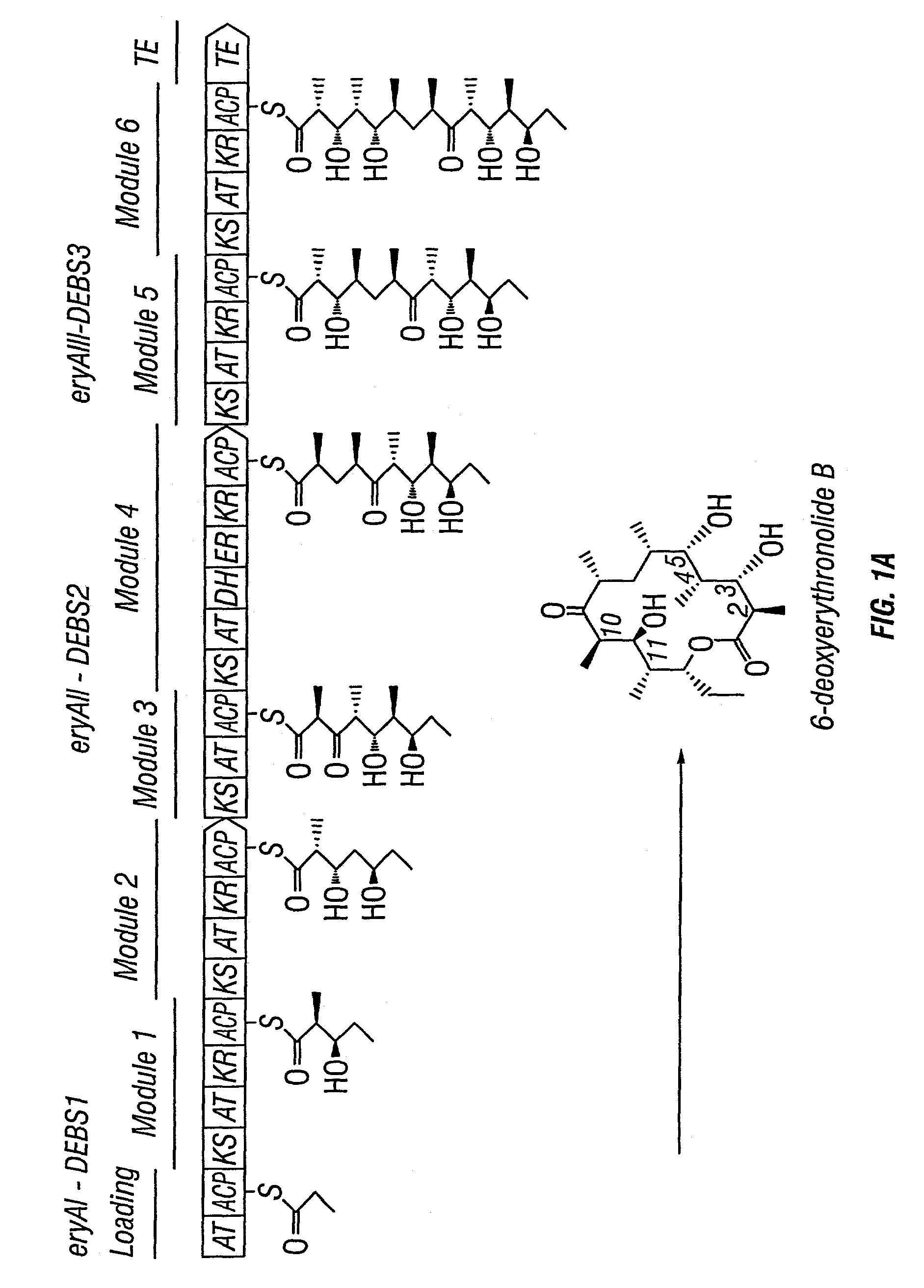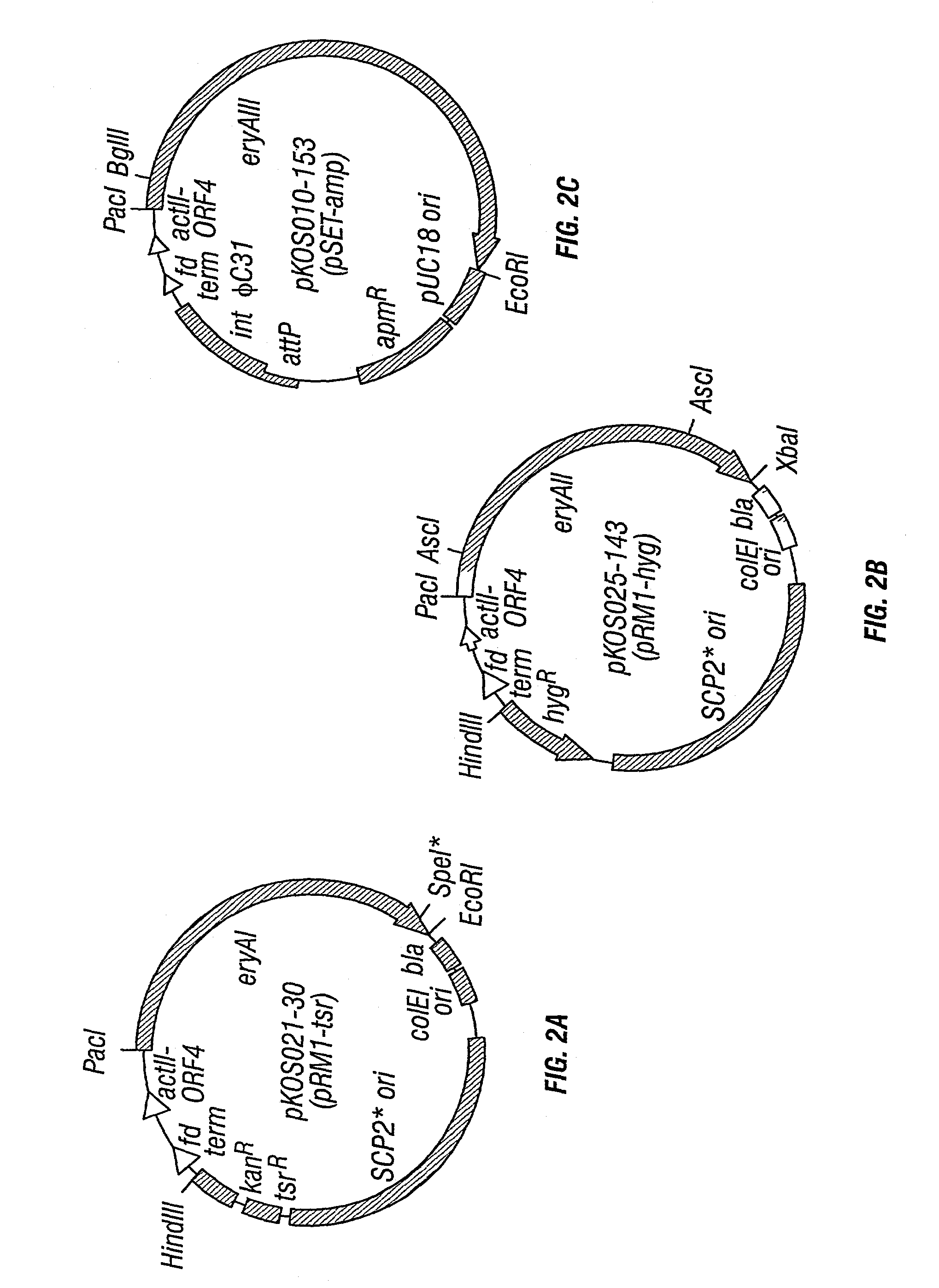Multi-plasmid method for preparing large libraries of polyketides and non-ribosomal peptides
a polyketide and non-ribosomal technology, applied in the field of recombinant dna compounds and host cells, can solve the problems of laborious preparation of very large libraries by this approach, and only a small fraction of what nature is capable of producing
- Summary
- Abstract
- Description
- Claims
- Application Information
AI Technical Summary
Problems solved by technology
Method used
Image
Examples
example 1
Construction of Expression Plasmids
[0052]In each vector, the eryA gene is expressed under the control of the upstream actI promoter and actII-ORF4 gene as previously described (see U.S. Pat. No. 5,672,491 and Ziermann et al., 2000, supra, both of which are incorporated herein by reference). For testing the high copy replicating plasmid possessing the pJV1 origin, the pB45 based E. coli shuttle vector pKOS025-32 was constructed by fusing pB45 with litmus 28 (New England Biolabs) at BglII and PstI sites. Into pKOS025-32 the ca. 14-kb HindIII-XbaI fragment containing the actI promoter and actII-ORF4 gene was inserted followed by the eyAII gene to give pKOS025-35. The configuration of the components in the HindIII-XbaI fragment is shown in FIG. 2B. The same HindIII-XbaI fragment was also cloned into shuttle vector pOSint1 / Hygro (see Raynal et al., 1998, Structure of the chromosomal insertion site for pSAM2: functional analysis in Eseherichia coli Molecular Microbiology 28: 333–342, inco...
example 2
Transfer of Mutation Cassettes into the Three-plasmid System
[0053]The plasmids containing eryAI mutations in module 2 were pKOS025-179 (AT2→rapAT2), pKOS038-1 (KR→rapDH / KR4) and pKOS038-3 (KR→rapDH / ER / KR1) and were made as follows. The PacI-SpeI fragments containing the corresponding mutations were transferred into the plasmids described in FIGS. 2A–2C from plasmids pKOS008-41, pKOS015-56 and pKOS015-57, respectively (see McDaniel et al., 1999, supra, and U.S. Pat. No. 6,403,775, filed 28 Oct. 1999, and PCT patent application US99 / 24483, filed 20 Oct. 1999, each of which are incorporated herein by reference). The plasmids containing the eryAIII mutations in module 5 were pKOS025-1831 (AT→rapAT2), pKOS025-1832 (KR→AT / ACP linker), pKOS025-1833 (KR→rapDH / KR4) and pKOS025-1834 (KR→rapDH / ER / KR1); and in module 6 were pKOS025-1841(KR→rapDH / KR4), pKOS021-106 (KR→AT / ACP linker) and pKOS025-1842 (AT→rapAT2). These were constructed as follows. The BglII-EcoRI fragments containing the correspo...
example 3
Streptomyces Transformation
[0054]Streptomyces lividans K4–1 14 and K4–155 (see U.S. Pat. No. 6,177,262, filed 28 Oct. 1998, and Ziermann et al., 1999, Recombinant polyketide synthesis in Streptomyces: engineering of improved host strain, Bio Techniques 26: 106–110, both of which are incorporated herein by reference) transformants were prepared according to standard methods (see Hopwood et al., 1985, supra) using apramycin (100 μg / mL), thiostrepton (50 μg / mL), and hygromycin (225 μg / mL) in the R5 protoplast regeneration plates. In the three-plasmid system for which eryAII / pSAM2-hyg replaced eryAII / SCP2*-hyg, S. lividans was transformed sequentially with pKOS010-153, pKOS038-67, and pKOS021-30.
PUM
| Property | Measurement | Unit |
|---|---|---|
| structure | aaaaa | aaaaa |
| size | aaaaa | aaaaa |
| antibiotic resistance | aaaaa | aaaaa |
Abstract
Description
Claims
Application Information
 Login to View More
Login to View More - R&D
- Intellectual Property
- Life Sciences
- Materials
- Tech Scout
- Unparalleled Data Quality
- Higher Quality Content
- 60% Fewer Hallucinations
Browse by: Latest US Patents, China's latest patents, Technical Efficacy Thesaurus, Application Domain, Technology Topic, Popular Technical Reports.
© 2025 PatSnap. All rights reserved.Legal|Privacy policy|Modern Slavery Act Transparency Statement|Sitemap|About US| Contact US: help@patsnap.com



